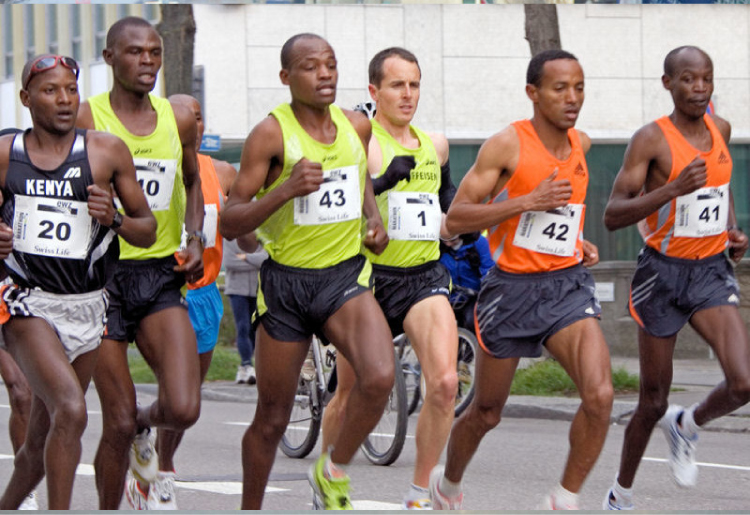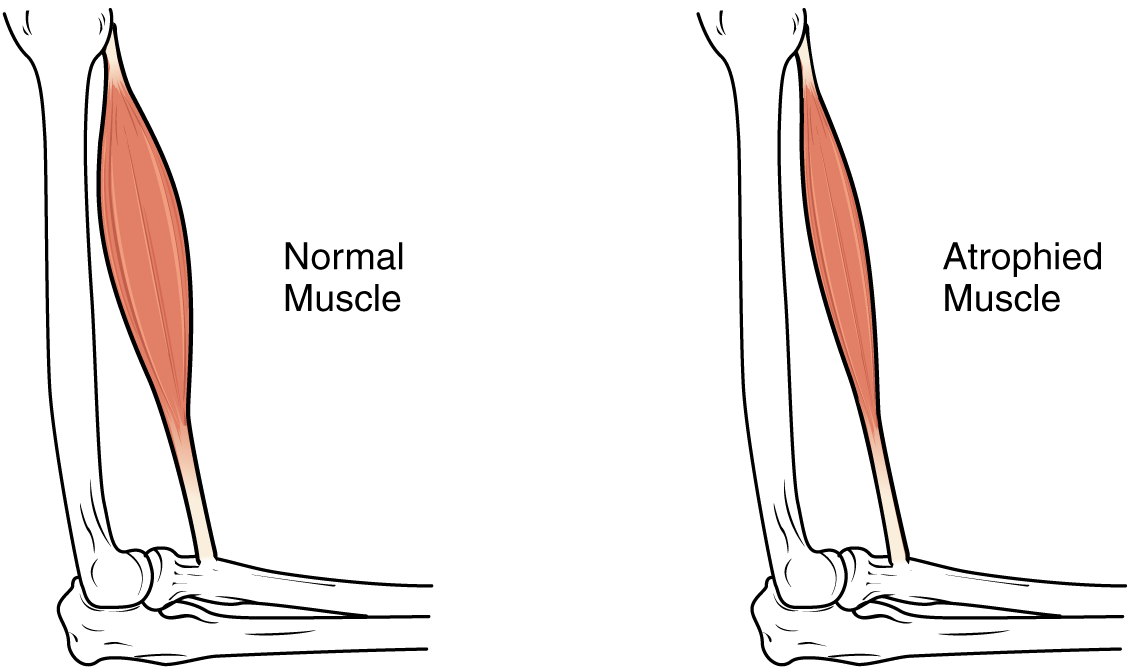
Physical training can alter the appearance of skeletal muscles and produce changes in muscle performance. Conversely, a lack of use can result in decreased muscle mass and performance. Although muscle cells can change in size, new cells are rarely formed when muscles grow. Instead, structural proteins are added to a muscle fiber in a process called muscle hypertrophy, resulting in an increase in fiber diameter. The reverse, when structural proteins are lost and muscle mass decreases, is called muscle atrophy.
Slow fibers are predominantly used in endurance exercises that require limited force generation but involve numerous repetitions. The aerobic metabolism used by slow oxidative fibers allows them to maintain contractions over long periods. Endurance training modifies these slow fibers to make them even more efficient by producing more mitochondria and synthesizing more myoglobin, both which lead to an increase in ATP production by increasing the rate of aerobic metabolism.
The training can trigger the formation of more extensive capillary networks around the fiber, a process called angiogenesis, to supply oxygen to the fibers and remove metabolic waste. To allow these capillary networks to supply the deep portions of the muscle, muscle mass does not greatly increase in order to maintain a smaller area for the diffusion of nutrients and gases.
The proportion of slow oxidative muscle fibers in muscle determines the suitability of a muscle for endurance, and may benefit those participating in endurance activities (Figure 10.6.1). Postural muscles have a large number of slow oxidative fibers as they are continually contracting to keep the body erect. Endurance athletes benefit greatly from having muscles containing a larger proportion of slow oxidative fibers compared to fast oxidative fibers. Studies suggest that genetics play a critical role in determining the overall fiber proportions of slow oxidative to fast glycolytic fibers in muscles with repetitive training having its greatest influence on the fast oxidative fibers.

Resistance exercises, as opposed to endurance exercise, target fast glycolytic fibers by focusing on short, powerful movements that are not repeated over long periods. The high rates of ATP hydrolysis and cross-bridge formation in fast glycolytic fibers is responsible for such powerful muscle contractions. Thus, muscles used for power often have a higher ratio of fast glycolytic fibers compared to slow oxidative fibers. Resistance exercise affects muscles by increasing the formation of myofibrils, thereby increasing the diameter of muscle fibers (Figure 10.6.2). Because this muscular enlargement is achieved by the addition of structural proteins, athletes trying to build muscle mass often ingest large amounts of protein.

In addition to the increase in muscle fiber diameter, resistance training also increases the development of connective tissue, adding to the overall mass of the muscle. Increases in connective tissue help to contain muscles as they produce increasingly powerful contractions. Tendons also become stronger to prevent tendon damage, as the force produced by muscles is transferred to tendons that attach the muscle to bone.
For effective strength training, the intensity of the exercise must continually be increased. For instance, continued weight lifting without increasing the weight of the load does not increase muscle size. To produce ever-greater results, the weights lifted must become increasingly heavier, making it more difficult for muscles to move the load. The muscle then adapts to this heavier load, and an even heavier load must be used if even greater muscle mass is desired.
If done improperly, resistance training can lead to overuse injuries of the muscle, tendon, or bone. These injuries can occur if the load is too heavy, or if the muscles are not given sufficient time between workouts to recover, or if joints are not aligned properly during the exercises. Cellular damage to muscle fibers that occurs after intense exercise includes damage to the sarcolemma and myofibrils. This muscle damage contributes to the feeling of soreness after strenuous exercise, but muscles gain mass as this damage is repaired, and additional structural proteins are added to replace the damaged ones.
Some athletes attempt to boost their performance by using various agents that may enhance muscle performance. Anabolic steroids are one of the more widely known agents used to boost muscle mass and increase power output. Anabolic steroids are a form of testosterone, a male sex hormone that stimulates muscle formation, leading to increased muscle mass.
Endurance athletes may also try to boost the availability of oxygen to muscles to increase aerobic metabolism by using substances such as erythropoietin (EPO), a hormone which triggers the production of red blood cells. The extra oxygen carried by these blood cells can then be used by muscles in the metabolic process.
Human growth hormone (hGH) is another substance often taken to give athletes an advantage. Although it can facilitate building muscle mass, growth hormone’s main role is to promote the healing of muscle and other tissues after strenuous exercise. Increased hGH may allow for faster recovery after muscle damage, reducing the rest required after exercise, and allowing for more sustained high-level performance.
Although performance-enhancing substances can improve performance, most are banned by governing bodies in sports and are illegal for non-medical purposes. Their use to enhance performance raises ethical issues of cheating because they give users an unfair advantage over nonusers. A greater concern, however, is that their long-term use can lead to use serious health issues that are often significant, nonreversible, and in some cases fatal.
Although muscle atrophy due to disuse can often be reversed with exercise, muscle atrophy with age, referred to as sarcopenia, is irreversible. This is a primary reason why even highly trained athletes succumb to declining performance with age. This decline is noticeable in athletes whose sports require strength and powerful movements, such as sprinting, whereas the effects of age are less noticeable in endurance athletes such as marathon runners or long-distance cyclists. As muscles age, muscle fibers die, and they are replaced by connective tissue and adipose tissue resulting in decreased muscle mass (Figure 10.6.3).
Because connective tissues cannot contract and generate force as muscle can, muscles lose the ability to produce powerful contractions. The decline in muscle mass causes a loss of strength, including the strength required for posture and mobility. There may also be a reduction in the size of motor units, resulting in fewer fibers being stimulated and less muscle tension being produced.

The effects of age-related atrophy are especially pronounced in people who are sedentary, as the loss of muscle cells is displayed as functional impairments such as trouble with locomotion, balance, and posture. This can lead to a decrease in quality of life and medical problems, such as joint problems because the muscles that stabilize bones and joints are weakened. Problems with locomotion and balance can also cause various injuries due to falls.
Sarcopenia can be delayed to some extent by exercise, as training adds structural proteins and causes cellular changes that can offset the effects of atrophy. These cellular changes may include greater numbers of mitochondria, increases in capillary density, and increases in the mass and strength of connective tissues.
Muscle hypertrophy is an increase in muscle mass due to the addition of structural proteins. The opposite of muscle hypertrophy is muscle atrophy, the loss of muscle mass due to the breakdown of structural proteins. Endurance exercise causes an increase in cellular mitochondria, myoglobin, and capillary networks in slow oxidative fibers. Endurance athletes benefit from a high proportion of slow oxidative fiber types relative to the other fiber types. Resistance exercise leads to muscle hypertrophy, primarily targeting fast glycolytic fibers. Power-producing muscles have a higher density of fast glycolytic fibers than of slow oxidative fibers. Some athletes use performance-enhancing substances to enhance muscle performance. Muscle atrophy due to age is called sarcopenia and occurs as muscle fibers die and are replaced by connective and adipose tissue.